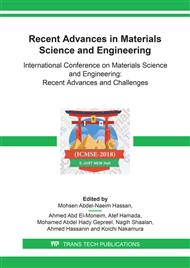p.44
p.52
p.57
p.65
p.75
p.87
p.98
p.104
p.119
Effect of Chemistry Modification, Hot Forging and Partitioning on Low Alloy Grade Tool Steel
Abstract:
Development of S6 tool steel has been discussed in this research by conducting a bit modification in the chemical composition using aluminum instead of molybdenum, and micro addition of boron to enhance the marteniste structure. Then, the hardenability and thermal stability have been detected in regarding to S6 tool steel. A novel isothermal treatment process has been suggested to enrich the retained austenite, and thereby, it has been tracked by using XRD, optical microscope, and SEM in conjugation with EDS. The effect of retained on the mechanical properties has been determined. The results ensure that aluminum has inhibited the graphite formation through the slow cooling regime. No change of hardenability or thermal stability of S6 tool steel triggered from adding of aluminum and microaddition of boron. In addition, the novel isothermal process leads to enrichment of retained austenite that has significantly affected on the combination of ductility with strength of the newly designed steel.
Info:
Periodical:
Pages:
75-83
Citation:
Online since:
October 2018
Price:
Сopyright:
© 2018 Trans Tech Publications Ltd. All Rights Reserved
Share:
Citation:


